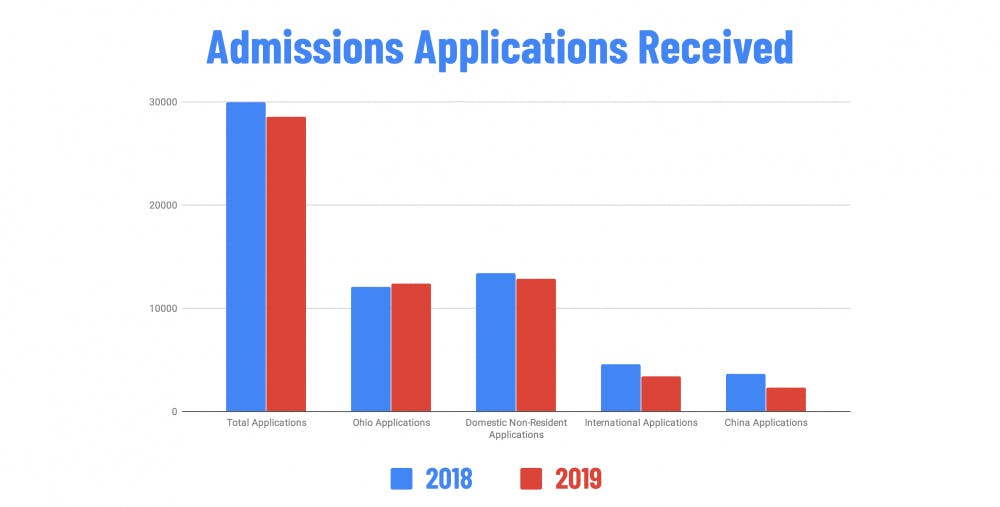The composition of Miami University's international student population will change with the class of 2023, as the number of Chinese students applying to Miami is down 37 percent from last year's numbers. The number of domestic student applications has stayed relatively constant, and Miami has admitted more students overall than it did last year.
The university received 1,335 fewer applications from Chinese students than it did for fall 2018 admission, which contributed to a 4.6 percent decline in applications overall. Over 200 more applications came in from countries other than China, with significantly more Vietnamese and Indian students considering Miami.
Susan Schaurer, associate vice president for strategic enrollment management and marketing, said that the university's student profile is reflective of the decline in Chinese students' applications.
"When you take any kind of loss from an area that's your largest feeder, just like Ohio would be domestically, you certainly feel that impact."
Aaron Bixler, associate director for international recruitment, said there are four factors contributing to the decrease in Chinese applications: the political relationship between the United States and China, Miami's U.S. and World Report rankings, the number of seats available in Chinese universities and the quality of Chinese universities. China has made an effort to improve its colleges in recent years, so more students are choosing to stay closer to home, Bixler said.
These factors affect the number of Chinese students choosing to study in the United States in general, not just at Miami.
According to The Institute of International Education, the number of new international students enrolling at U.S. universities decreased by 6.3 percent from the 2016-17 school year to 2017-18, which is the most recent data.
"I think we've been proactive [when recruiting] in China for a while, and I think that's helped with maybe delaying the decrease in applications from China that other schools have begun seeing maybe a couple years ago," Bixler said. "We've managed to stay more or less even, but I think it's catching up to us."
Despite the decline in applications from China, Schaurer remains positive about the incoming class' ability to succeed at Miami.
"While you see applications decreasing slightly, when you look at the quality of the applicant pool and quality of the students you're admitting, we're in a great position," Schaurer said. "We have really made efforts on recruiting the right type of student."
Those efforts have paid off, as high school seniors who were accepted to Miami have an average GPA of 3.9 and an average ACT score of 28.9, both of which are increases from the current first-year cohort.
Decreased population numbers account for decline in domestic applications
Enjoy what you're reading?
Signup for our newsletter
A regional population decline in the U.S. means that fewer students are graduating high school and applying to college.
According to the Western Interstate Commission for Higher Education (WICHE), there were approximately 124,500 high school graduates in Ohio in 2018. That number is expected to drop by 2,500 in 2019. By 2029, WICHE expects Ohio will only have 108,300 high school graduates, which is an 11.6 percent decrease over 10 years.
These trends are expected to continue in Ohio as well as the Midwest and Northeast U.S., the two regions where Miami receives the highest number of out-of-state applications.
Regional populations are predicted to grow in the Southeast, Southwest and Pacific Northwest, so Schaurer said Miami is aiming to increase recruitment efforts in these areas.
Meanwhile, the overall decrease in applications is affecting schools across the state of Ohio.
Craig Cornell, senior vice provost for strategic enrollment management at Ohio University (OU), said their overall enrollment numbers have decreased 4.1 percent in the past year.
The University of Akron saw a 7 percent decrease in enrollment from 2017 to 2018, according to data on their website.
WICHE predicts enrollment data 13 years in advance, meaning Miami admissions staff anticipated the decline in applications. This prediction led to the implementation of new programs at Miami such as the Presidential Fellows, a full scholarship program which is being introduced with the class of 2023.
Miami also began Red Brick Roadshows this year. This is a program where admissions staff visit cities across the country in January, inviting accepted students to learn more about Miami and meet with young alumni from that city. The roadshows allow students to interact with representatives from Miami in their hometown. Schaurer's staff hopes that engagement entices students to come to a Make it Miami event later in the spring.
Admissions staff have visited 1,993 high schools this year compared to 635 schools in 2011.
All of the admissions data listed are current as of Feb. 17. These numbers could change slightly as more students apply.




